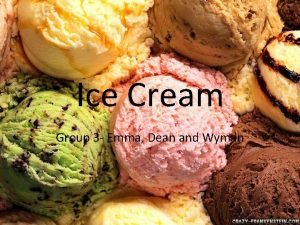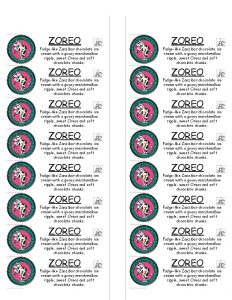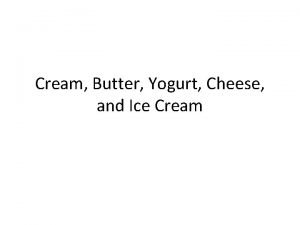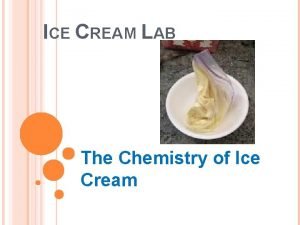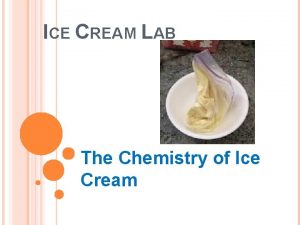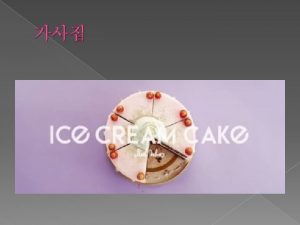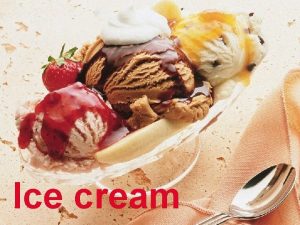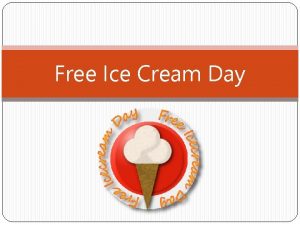Ice Cream Group 3 Emma Dean and Wyman









- Slides: 9

Ice Cream Group 3 - Emma, Dean and Wyman

What is ice cream? • Ice cream is a frozen dairy product that comes in a wide range of flavours and colours. It’s used as a dessert, and to accompany things like pie and cake. This frozen product is enjoyed all over the world, but more so in America.

Why was ice cream developed and who developed it? • Ice cream was developed to be a refreshing, cooling treat, that was favoured among royalty for sometime before entering the home. • Ice cream is thought to have been developed from flavoured ices and water ices. The Romans and Chinese are the earliest reports of people enjoying these ices. In the 13 th century, an Italian explorer named Marco Polo was said to have returned from China with recipes for water ices, which are like snow cones. This may have been when ice cream development started. • Ice cream was made at homes until American Jacob Fussell established the first ice cream plant in Baltimore, 1851.

Ice cream history • Ice cream origins can be traced back to the 4 th century B. C, to the Romans. The Romans had recipes for shaven ice concoctions, and in the 13 th century, Marco Polo came back from China with recipes for water ices. It’s thought this may have been when ice creams started developing. • Ice cream was brought to America in the 1700’s and was quite a luxury. It was all made at home until Jacob Fussell opened the first ice cream plant in 1851.

How is ice cream made in a factory? • Ice cream is a hit whether homemade or factory made. In factories, the ice cream mix-which consists of milk products, sugar and flavourings is put into a huge vat. It’s then pasteurized which means it’s sterilized so it can keep for longer, before being homogenised, which breaks down the fat particles and helps make the ice cream smooth. The mix then goes into a cooler, then a storage tank where it’s frozen for 3 -4 hours. Flavourings and colours are then added, and then the mix is frozen again.

How is ice cream made at home? • If you’re making ice cream at home, you combine egg yolks and sugar. Then, place a pot on the stove containing milk and leave this until it is starting to boil. You then remove it from the stove and add the egg yolks and sugar, before returning it to the stove, where you heat it-stirring continuously-until the mixture sticks and covers the back of the spoon. Place this mixture in a bowl, let it cool in a water bath, add cream and the place in the freezer for at least 24 hours. Once removed from the freezer, pour it into an ice cream churner/maker for about 20 -30 minutes, then eat or freeze. Flavours can be added in whatever way you feel will be most successful. • Ice cream can be made without an ice cream maker, but it does take longer. The mix is kept in a freezer, but has to be taken out and stirred every so often.

How is ice cream eaten and who eats it? • Ice cream is generally licked or sucked; whether off a spoon, off a pastry, out of a cone or off a stick. • Anyone can enjoy the cool, sweet taste of ice cream. Children age 2 -12 years and adults 45 years old plus eat the most ice cream person. • Fact: More ice cream is sold on Sunday then any other day of the week.

What is ice creams nutritional value? • In basic vanilla ice cream, its nutritional value is: (per serving of ½ a cup, or 72 grams) It has a total of 145 calories. • Fat total: 7. 9 g/12% • Saturated fat: 4. 9 g/ 24% • Polyunsaturated fat: 0. 3 g • Monounsaturated fat: 2. 1 g • Cholesterol: 32 mg/11% • Sodium: 58 mg/2% • Carbohydrates total: 17. 0 g/6% • Dietary fibre: 0. 5/2% • Sugars: 15. 3 g • Protein: 2. 5 g

Bibliography • http: //science. howstuffworks. com/innovation/edibleinnovations/ice-cream 2. htm (Accessed 15. 02. 2013) • http: //www. library. ebonline. co. nz. libezp 01. slc. ac. nz/comptons/arti cle-202332? query=ice%20 cream%20 history&ct (Accessed 15. 02. 2013) • Shaffer, J. (2013). Ice cream. In Public Libraries. Retrieved from http: //www. worldbookonline. com/pl/infofinder/article? id=ar 2708 40&st=ice+cream (Accessed 15. 02. 2013) • http: //nutritiondata. self. com/facts/sweets/5405/2 (Accessed 15. 03. 2013) • http: //caloriecount. about. com/calories-ice-creams-vanilla-i 19095 (Accessed 15. 03. 2013) • Google images (Accessed 15. 03. 2013)
